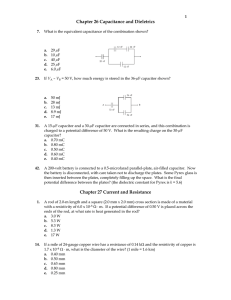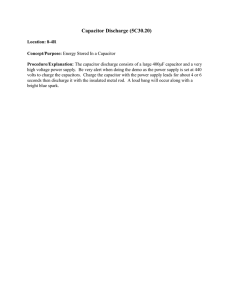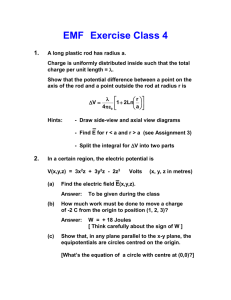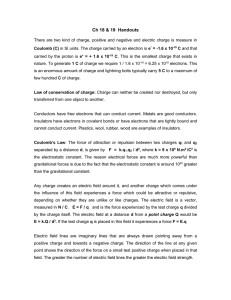Physics: Electromagnetism Spring 2007 PROBLEM SET 7 Solutions
advertisement
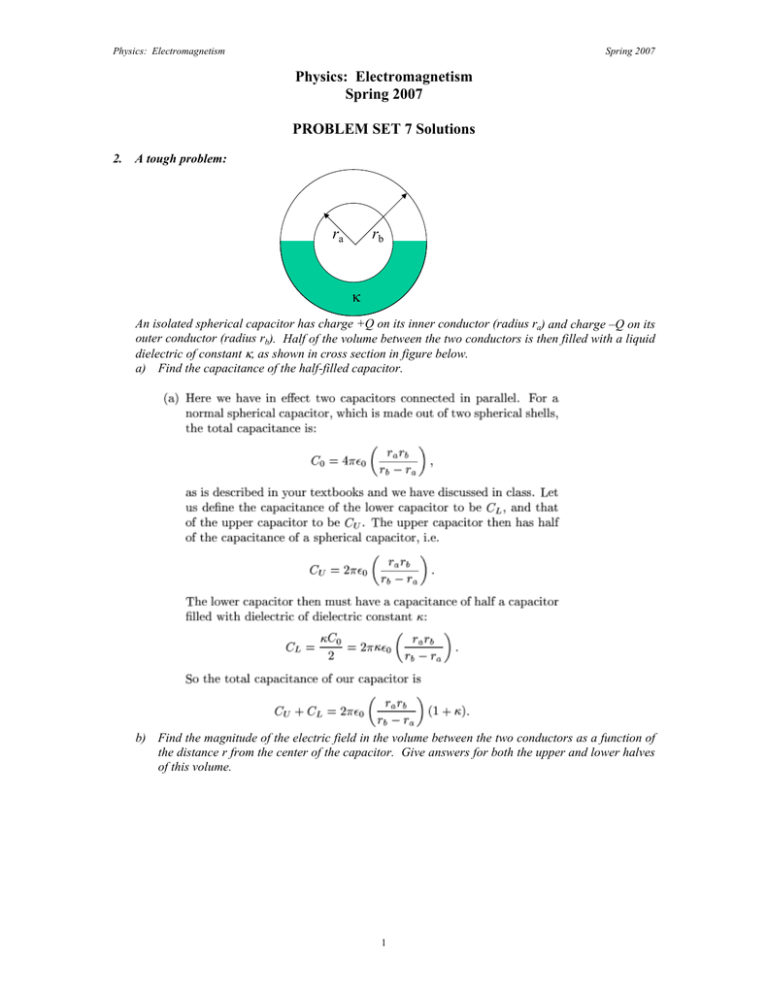
Physics: Electromagnetism Spring 2007 Physics: Electromagnetism Spring 2007 PROBLEM SET 7 Solutions 2. A tough problem: ra rb κ An isolated spherical capacitor has charge +Q on its inner conductor (radius ra) and charge –Q on its outer conductor (radius rb). Half of the volume between the two conductors is then filled with a liquid dielectric of constant κ, as shown in cross section in figure below. a) Find the capacitance of the half-filled capacitor. b) Find the magnitude of the electric field in the volume between the two conductors as a function of the distance r from the center of the capacitor. Give answers for both the upper and lower halves of this volume. 1 Physics: Electromagnetism c) Spring 2007 Find the surface density of free charge on the upper and lower halves of the inner and outer conductors. 2 Physics: Electromagnetism Spring 2007 d) Find the surface density of bound charge on the inner (r = ra) and outer (r = rb) surfaces of the dielectric. e) 3. What is the surface density of bound charge on the flat surface of the dielectric? Explain. Biophysics Stuff: a) Wolfson and Pasachoff, Ch. 27, Problem 5, p. 704 The charge moving through the membrane each second is 30 nC. Since singly-charged ions carry one elementary charge (about 160 zC = 1.6 × 10 −19 C), this corresponds to 30 nC/(160 zC/ion) = (1.88 × 10 ion) /(6.02 × 1023 ion/mol) = 0.311 pmol 11 or simply 1.88 × 10 ions. (See Example 27-2(a), Appendix B, and Table 1-1.) Chemical drug-testing instrumentation can detect amounts of substances this low. 11 b) A torpedo, a giant saltwater ray that can develop a voltage of 220 V, is covered with cells known as electroplaques, each of which produces a potential difference of about 0.15 V. Several thousand rows (each made up of a series-connected array of cells0 ate then connected in parallel to build up a sizable current. How many cells would you guess form each row? Why do freshwater electric fish in general develop higher voltage than saltwater ones? Each cell produces 0.15V and a total of 220 V is developed, which mans that n such cells are connected in series in a row, where n = 220 V/ (0.15 V/cell) = 1.5 x 103 cells. Saltwater, because of the rich presence of conducting ions, is a much better conductor of electricity than freshwater; so a saltwater electric fish can produce a significant amount of electric current with a relatively low voltage. 3 Physics: Electromagnetism 4. Spring 2007 Brain Teasers a) If the drift speed of electrons in a conductor is very slow, why does a ceiling bulb go on so soon after the wall switch is closed? b) Why is it possible for birds to perch on power transmission lines without being electrocuted? c) Why is the energy spent by a battery to charge a capacitor is twice larger than that stored within a capacitor as a result of a battery’s work? Half of the energy spent by a battery is lost on raising the potential difference between the plates of the capacitor while the other half is stored in separating the charge. The truth is that the energy spent on raising the potential difference between the capacitor plates can also be referred to as the energy loss due to resistance because a capacitor does “resist” to raising the potential difference or collecting separated charge on its plates. 5. Real Life Problem: A cylindrical tube of length l has an inner radius a and an outer radius b, as shown in Figure below. The resistivity is ρ. What is the resistance between the ends? b a l By definition of resistance in terms of resistivity, the length, and cross-sectional area of the conductor, we have 4 Physics: Electromagnetism Spring 2007 l R=ρ A . ( We can re-write the cross-sectional area for the tube in this problem as A = π b − π a = π b − a 2 2 2 2 ). Then, the resistance of the tube is R=ρ 6. l π (b − a2 ) 2 . Hypothetical Problem: Wolfson and Pasachoff, Ch. 27, Problem 65, p. 707 ˆ (The coordinate system we chose here is The current density is J = (0.1 A/cm )( x /10 cm)k. such that the z-axis runs along the length of the metal bar and the x-axis runs along the vertically.) The cross section can be divided into strips of area dA = (5 cm) dx k (where dx is small enough for J to be constant over this region), so the total current in the bar is: 2 I= ∫ J ⋅ dA = ∫ x -sect 7. 10 cm 0 1 (10 −2 A/cm 3 )(5 cm) x dx = (0.05 A/cm 2 ) (10 cm) 2 = 2.5 A. 2 Real Stuff! Wolfson and Pasachoff, Ch. 27, Problem 71, p. 708 As suggested, consider that the total resistance R equals R = ∫ cone dR , where dR = ρ dx / A is the resistance of a thin disk as shown on Figure 27-27 of your textbook. The area of such a disk is A = π y 2 , where y = a + (b − a) x / A is the radius and 0 ≤ x ≤ A, as shown in the figure. Then A ρ ⎛ A ⎞ 1 ρ ⎛ A ⎞ ⎛ 1 1 ⎞ ρA = −⎜ = ⎜ − = R=∫ . ⎟ 2 0 π [a + (b − a ) x / A ] π ⎝ b − a ⎠ [a + (b − a) x / A] 0 π ⎝ b − a ⎟⎠ ⎜⎝ a b ⎟⎠ πab A ρ dx (This result depends on the condition that the flat faces and parallel circular cross-sections of the cone are equipotential surfaces.) 8. ECE/Materials Science: How to understand electric properties of a material with impurities. The resistivity of a semiconductor can be modified by adding different amounts of impurities. A rod of semiconducting material of length L and cross-section area A lies along the x-axis between x = 0 and x = L. The material obeys Ohm’s law, and its resistivity varies along the rod according to ρ (x) = ρ0 exp (-x/L). The end of the rod at x = 0 is at a potential V0 greater than the end at x = L. a) Find the total resistance of the rod and the current in the rod. 5 Physics: Electromagnetism Spring 2007 b) Find the electric field magnitude E(x) in the rod as a function of x. c) Find the electric potential V(x) in the rod as a function of x. d) Graph the functions ρ(x), E(x), and V(x) for values of x between x = 0 and x = L. 6 Physics: Electromagnetism Spring 2007 7

